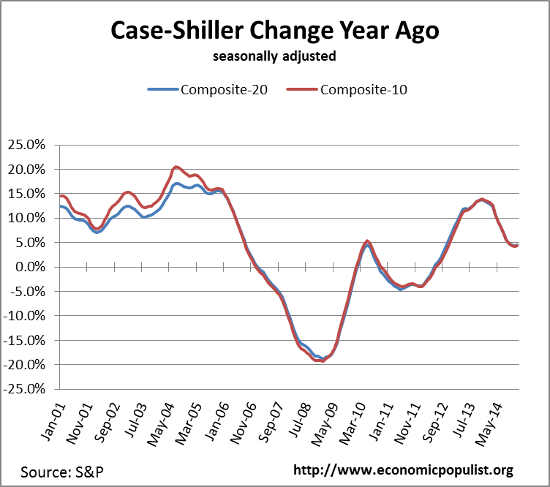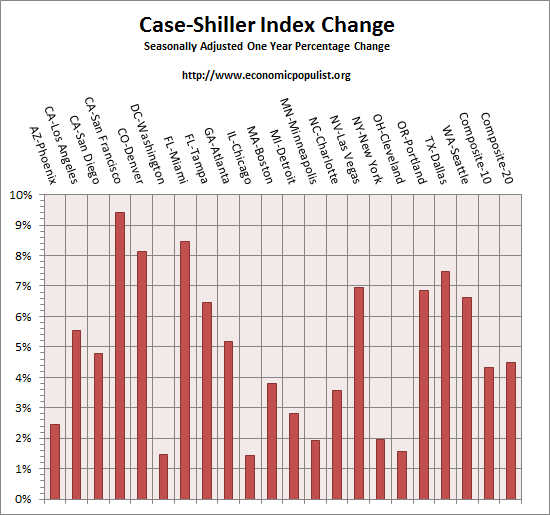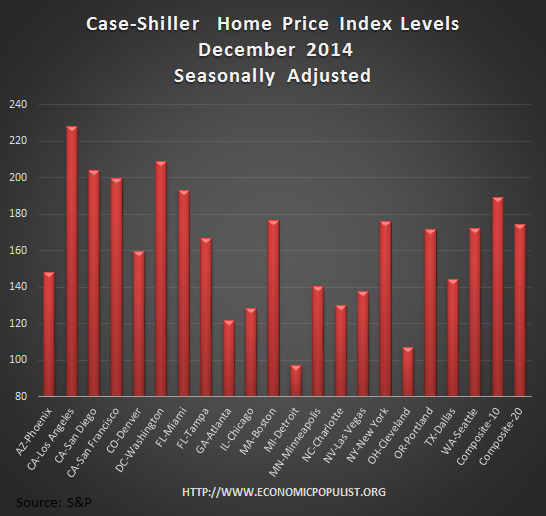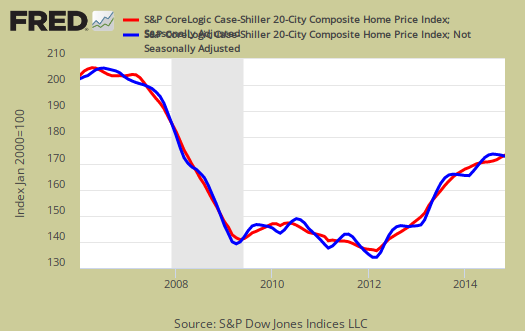The December 2014 S&P Case Shiller home price index shows a seasonally adjusted 4.5% price increase from a year ago for the 20 metropolitan housing markets and a 4.3% yearly price increase in the top 10 housing markets. There are two ways to look at the never ending increasing home prices. The first is an overall slowdown in the rate of these increases while the second is how prices are double what the rate of inflation is. Generally speaking homes are not affordable. There are no city areas where home prices have declined. Since March 2012, the 10-City composite index has increased 28.2% and the 20-City composite index has increased 29.1%. From the housing bubble 2006 peaks, prices are now only down about 16-17%.

Below are all of the composite-20 index cities yearly price percentage change, using the seasonally adjusted data. San Francisco home prices increased 9.3% from a year ago and Miami also increased by a large amount, 8.4%. Silicon valley is clearly not affordable even for people making six figures. The west prices are generally increasing more than other parts of the country. S&P blames this on decreasing social mobility, yet does not mention the lack of affordability for most workers.

S&P reports the not seasonally adjusted data for their headlines. Housing is highly cyclical. Spring and early Summer are when most sales occur. For the month, the not seasonally adjusted composite-20 percentage change was -0.1% whereas the seasonally adjusted change for the composite-20 was 0.9%. The not seasonally adjusted composite-10 saw a 0.1% increased from last month, whereas the seasonally adjusted composite-10 showed a 0.8% increase. December is winter so the not seasonally adjusted increase should be less than the seasonally adjusted composite-20. The below graph shows the seasonally adjusted monthly percentage change.

Prices are normalized to the year 2000. The index value of 150 means single family housing prices have appreciated, or increased 50% since 2000 in that particular region. Case-Shiller indices are not adjusted for inflation. Below are the seasonally adjusted levels for the month.

S&P believes the housing recovery is faltering, fairly surprising since prices are still on the rise. Below is a quote from S&P:
The housing recovery is faltering. While prices and sales of existing homes are close to normal, construction and new home sales remain weak. Before the current business cycle, any time housing starts were at their current level of about one million at annual rates, the economy was in a recession
Bottom line home prices are not affordable in most cities, or at least in California land. The rate maybe decelerating or increasing but there is no slowdown to the rate of inflation for homes. There are many other housing indicators showing this is the case. Notice the conflicting statements from S&P versus NAR on the health of housing. NAR seems to finally be recognizing the affordability question whereas S&P just seems interested in watching prices increase and increase.
To Season or Not to Season, That is the Question:
The S&P/Case-Shiller Home Price Indices are calculated monthly using a three-month moving average and published with a two month lag. Their seasonal adjustment calculation is the standard used for all seasonal adjustments, the X-12 ARIMA, maintained by the Census. The headlines and Case-Shiler's report uses the not seasonally adjusted data. Not seasonally adjusted data can create more headline buzz on a month by month basis due to the seasonality of the housing market. S&P does make it clear that data should be compared to a year ago, to remove seasonal patterns, yet claims monthly percentage changes should use not seasonally adjusted indices and data. This seems more invalid than dealing with the statistical anomalies the massive housing bubble burst caused. Below is the seasonally adjusted and not seasonally adjusted Composite-20 Case-Shiller monthly index, for comparison's sake.

For more Information:
S&P does a great job of making the Case-Shiller data and details available for further information and analysis on their website.
Here is our Case-Shiller past overviews as well as the overviews of residential real estate statistics.

Recent comments